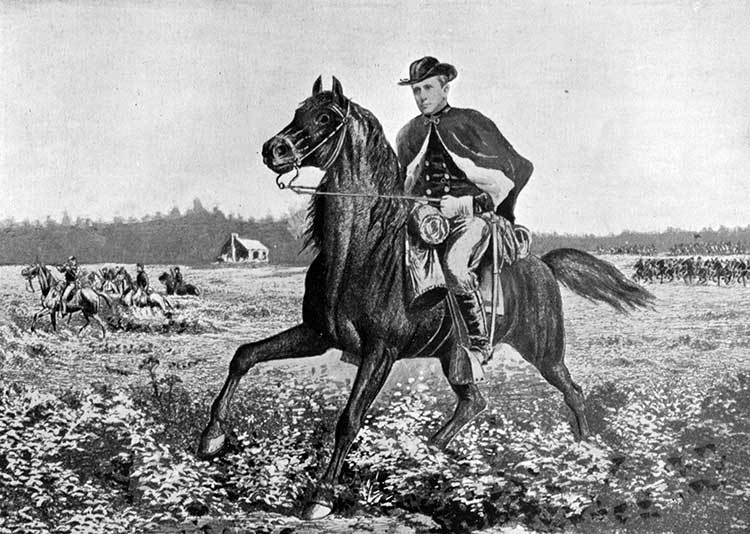The Kirwan or Kerwin Family

(Crest No. 240. Plate 52.)
THE Kirwan family is descended from Milesius, King of Spain, through the line of his son Heremon. The founder of the family was Brian, son of Eocha Moy Veagon, King of Ireland, A. D. 350, son of Fiachra the Fifth, surnamed Finola, King of Ireland, A. D. 73, son of Fearadach, King of Ireland, A. D. 56, son of Crimthan Nianair, King of Ireland, A. D. 39.
The Irish form of the name was O’Ciardubhain O’Keerawaun, which was formed by prefixing ciar to dubhan, words both of which have the same meaning—“a dark complexioned man.” The name is widely diffused in the County of Galway. During the Cromwellian wars many of the Connaught septs were driven into Munster, among them the O’Kirwan or Kerwin family.
Among the many eminent ecclesiastics of this name was the Most Rev. Francis Kirwan, Bishop of Killala, born in Galway in 1589. He was educated in Portugal and France, and returned to Ireland in 1620, where he labored for some years among the wilds and islands of the west. He returned to France in 1629, and was consecrated Bishop of Killala in Paris in 1645. After the fall of Galway in 1651, he escaped Cromwell’s troops by remaining for months concealed in a wretched garret, overrun with rats and mice. He was afterward seized and imprisoned, and after many sufferings was banished to France, where he died in 1661.
Richard Kirwan, LL. D., the eminent chemist and geologist, was also a native of Galway. He made his studies at Trinity College, Dublin, and St. Omer’s, France. He devoted his life to science, and may be regarded as one of the fathers of modern chemistry. He was for a time President of the Royal Irish Academy. He was the author of numerous works of great merit in their day on chemistry, geology, and meteorology. An enthusiastic lover of Irish music, he traveled with and assisted Bunting in making his collection of old Irish tunes and airs. He was eccentric in his habits, and distinguished for his generosity and unselfishness. Castlereagh offered him a baronetcy if he would support the Union, but he indignantly spurned the bribe and opposed that infamous measure with all his energy. He died in 1812.
A worthy representative of this name is General Michael Kerwin of New York. A native of the County of Wexford, Ireland, he came to the United States at an early age, and was educated in the Christian Brothers’ Academy in Philadelphia. While yet a student he joined a military organization, and when the Civil War broke out he enlisted in the Union army. At an early stage of the conflict Gen. Patterson advanced with his command into Virginia. Before crossing the Potomac he wished to gain a knowledge of the strength of the enemy, and desired a reliable and brave soldier to enter the Confederate lines and bring back a statement of their position and their strength. Among the many volunteers for this dangerous service, Michael Kerwin was chosen. Having assumed the necessary disguise, young Kerwin crossed the enemy’s lines at Martinsburg, estimated the opposing force, and came back to his commanding officer, General Negley, with his information. General Negley was convinced that Private Kerwin was worthy of promotion.

GENERAL M. KERWIN,
Pennsylvania Cavalry, Union Army.
Subsequently, when Milroy’s little force was routed, June 15, 1863, by Lee’s army, Major Kerwin, at the head of a single regiment, met the over-confident rebel cavalry and held them in check until the Union forces were re-formed. After leaving the valley, Colonel Kerwin’s next appointment brought him into conflict with General Lee’s army at White Sulphur Springs, Warrenton, Va. General Lee sought by a sudden movement to turn the Union right. At this critical moment Colonel Kerwin, with the Fourth Pennsylvania Cavalry, combated Ewell’s columns for six hours, thus giving Gen. Meade time to cross the Rappahannock and thereby checkmate the wily scheme of Lee. This gallant and desperate stand of Colonel Kerwin’s command was effected with fearful loss of life.
Again in 1864 Colonel Kerwin was assigned to a desperate position while serving under General Sheridan in the Second Brigade of Gregg’s Division. He carried out his orders with success.
In 1865 Colonel Kerwin, under secret orders from General Grant, took his command from City Point to Wilmington, N. C., and met Sherman, then “marching through Georgia.” On joining the grand column at Fayetteville, Colonel Kerwin was assigned to the generalship of the Third Brigade of Kilpatrick’s Division.
After the conclusion of hostilities General Kerwin was placed in command of seven counties in North Carolina during the reconstruction period, and managed the affairs of his department with singular skill and ability.
In 1865, while Ireland was in a state of incipient rebellion and the United States was in an angry mood on account of the treacherous part acted by England during the Civil War, General Kerwin was sent to Ireland to look over the ground as a man of military experience and proved ability. At great personal sacrifice he responded to the call. He held an interview with the Irish leader, James Stephens, where no eye could see them or ear could hear them. There General Kerwin, his mind schooled in our Civil War, told his experience of military affairs, and impressed on the Irish leader that Ireland was in no condition to enter on a military struggle with England while the latter nation was in a state of peace.
Before returning to America, however, General Kerwin met the Irish leaders in military council, and had his plans been acted on at the time it might have added a new chapter to Irish history. In 1888 General Kerwin was appointed by President Harrison Collector of Internal Revenue, New York, and afterward held the position of Commissioner of Police, New York City.
